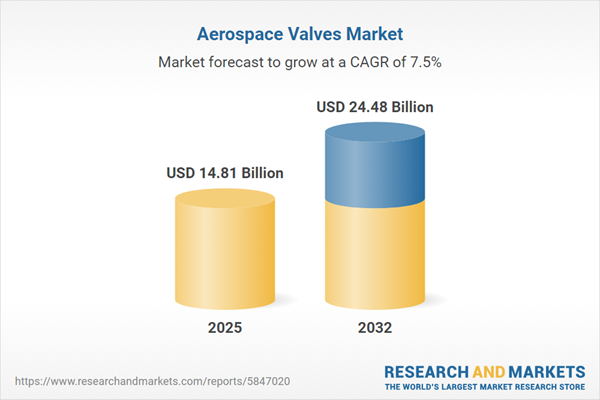Speak directly to the analyst to clarify any post sales queries you may have.
The aerospace valves market is navigating a period of profound transformation driven by technological advancement, regulatory change, and strategic supply chain realignments. For senior decision-makers, keeping pace with these shifts is crucial to ensure stable operations and to sharpen competitive positioning within a globally connected aerospace sector.
Market Snapshot: Aerospace Valves Market Size and Growth Trajectory
The global aerospace valves market reached USD 13.76 billion in 2024 and is projected to grow to USD 14.81 billion by 2025, at a compound annual growth rate of 7.46%. This upward trend reflects sustained modernization across commercial, defense, and space aerospace programs. Major growth drivers include robust infrastructure investments and the adoption of advanced valve architectures designed for system reliability and operational flexibility. Ongoing development of smart valve technologies and new integration approaches is opening broader applications, serving both established fleets and cutting-edge aerospace platforms.
Aerospace Valves Market: Scope & Segmentation
This market research delivers actionable insights for leaders responsible for investment, risk, and procurement strategies. Segmentation clarifies technology priorities and regulatory requirements, supporting informed decisions among program managers and business development executives in the aerospace sector.
- Valve Types: Ball, butterfly, check, control, gate, flow control, and pressure reducing valves are integral to meeting safety, efficiency, and compliance needs across aerospace systems.
- Actuation Methods: Electric, hydraulic, manual, and pneumatic actuators enable various automation levels and promote reliability, from commercial aircraft interiors to space modules.
- Materials: Aluminum, nickel alloys, stainless steel, and titanium offer tailored durability and lifecycle management solutions for diverse aerospace environments and mission profiles.
- End Users: Commercial aircraft, helicopters, UAVs, military vehicles, and space systems each have unique operational and certification demands shaping procurement choices and supplier partnerships.
- Pressure Ratings: High, medium, low, and ultra-high-pressure valves ensure safety performance and system compatibility with evolving aerospace standards and operational contexts.
- Body Construction: One-piece, two-piece, and three-piece assemblies provide maintenance and lifecycle advantages, contributing to effective aftersales support and tailored maintenance regimes.
- Regions: Comprehensive coverage includes the Americas, Europe, Middle East & Africa, and Asia-Pacific, analyzing growth drivers, regulatory changes, and adoption trends in leading markets such as the US, Germany, and China.
- Leading Companies: Featured profiles of Parker-Hannifin, Eaton, Honeywell, Moog, Woodward, Safran, Curtiss-Wright, Triumph Group, Barnes Group, and TriMas enable benchmarking of industry benchmarks and supplier differentiation.
Aerospace Valves Market: Key Takeaways for Senior Decision-Makers
- Integration of smart valve systems with built-in sensors is strengthening maintenance planning and enabling predictive maintenance that supports higher system uptime and operational efficiency.
- Additive manufacturing facilitates production of lighter, adaptable valve designs, allowing for agile response to shifting aerospace mission requirements and tailored component specifications.
- Regional sourcing strategies support risk mitigation, enhancing supply chain resilience against changes in raw material costs and international trade dynamics.
- Advances in material science and increased digitalization are enabling solutions that better align with client specifications and enhance responsiveness to compliance and operational needs.
- Commitment to sustainability and process improvement is reinforcing equipment reliability and supporting industry expectations for environmental responsibility.
Tariff Impact on Aerospace Valve Value Chains
Recent changes in US tariff policies are prompting aerospace valve manufacturers to reevaluate sourcing, emphasizing regional supply networks and greater transparency in procurement. These developments are strengthening value chain adaptability, reducing susceptibility to regulatory changes, and promoting operational resilience amid evolving trade environments.
Methodology & Data Sources
Insights are grounded in executive interviews, regulatory trend analysis, industry white paper reviews, and patent assessments. Scenario modeling techniques were employed to evaluate both present and projected impacts of technology and policy developments on aerospace valves market outlooks.
Why This Report Matters
- Helps leaders anticipate sector changes and align investment strategies with evolving customer needs and regulatory demands.
- Provides thorough segmentation and benchmarking to guide risk management, procurement planning, and supplier selection.
- Supports identification of emerging growth areas and informs acquisition strategies through competitive insight and market mapping.
Conclusion
With targeted insights from this report, senior decision-makers can strengthen procurement approaches, anticipate regulatory changes, and prioritize sustainability, positioning their organizations to lead in the evolving aerospace valves market.
Additional Product Information:
- Purchase of this report includes 1 year online access with quarterly updates.
- This report can be updated on request. Please contact our Customer Experience team using the Ask a Question widget on our website.
Table of Contents
3. Executive Summary
4. Market Overview
7. Cumulative Impact of Artificial Intelligence 2025
Companies Mentioned
The companies profiled in this Aerospace Valves market report include:- Parker-Hannifin Corporation
- Eaton Corporation plc
- Honeywell International Inc.
- Moog Inc.
- Woodward, Inc.
- Safran S.A.
- Curtiss-Wright Corporation
- Triumph Group, Inc.
- Barnes Group Inc.
- TriMas Corporation
Table Information
| Report Attribute | Details |
|---|---|
| No. of Pages | 195 |
| Published | October 2025 |
| Forecast Period | 2025 - 2032 |
| Estimated Market Value ( USD | $ 14.81 Billion |
| Forecasted Market Value ( USD | $ 24.48 Billion |
| Compound Annual Growth Rate | 7.4% |
| Regions Covered | Global |
| No. of Companies Mentioned | 11 |









